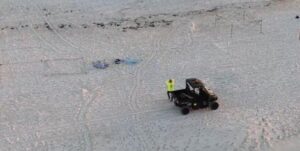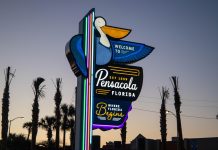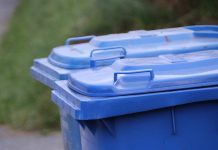Primer nido de tortuga boba del 2021 registrado en Pensacola Beach
PENSACOLA BEACH, Fla. – La Patrulla de Tortugas Marinas del Condado de Escambia registró el primer nido depositado en las playas del condado en Pensacola Beach temprano esta mañana, 28 de mayo, para dar inicio a la primera temporada de anidación del 2021.
La caguama hembra tuvo que arrastrarse a través de varias carpas que quedaron en la playa durante la noche antes de encontrar un sitio adecuado para anidar. Al parecer esta hembra pudo regresar de manera segura al Golfo, las carpas, sillas y otros muebles que se dejan en la playa durante la noche presentan obstáculos peligrosos para las hembras anidadoras.
Las tortugas marinas de todos los tamaños enfrentan muchas amenazas. Para las hembras que anidan, los muebles, carpas y juguetes que se dejan en la playa durante la noche crean obstáculos que pueden atraparlas o lesionarlas durante un intento de anidación. Las luces blancas en la playa pueden disuadirlas de anidar o hacer que abandonen un intento de anidación, también conocido como rastreo en falso.
“Afortunadamente, los artículos personales que se dejaron en la playa no disuadieron a la tortuga boba de anidar,” dijo Tim Day, Director de Manejo de Recursos Naturales. “Queremos recordarles a los bañistas que no dejen rastro y sigan la guía para proteger a nuestras tortugas marinas esta temporada.”
Cuatro especies de tortugas marinas anidan en las playas del condado de Escambia de mayo a octubre, tortugas verdes, tortugas laúd y la rara tortuga lora de Kemp. Las tortugas bobas son las que anidan más comúnmente y representan más del 90% de los nidos puestos cada año. Una vez puestos, los huevos se incubarán durante unos 60 días, después de lo cual las crías emergen al amparo de la oscuridad y se dirigen al Golfo de México.
Los bañistas pueden ayudar a proteger º las tortugas marinas que anidan en el condado de Escambia recordando:
- Retire todos los muebles y juguetes de la playa cuando termine el día, incluidas las hamacas, carpas, toldos, sillas, juguetes y equipo deportivo.
- Las tortugas hembras prefieren playas oscuras y tranquilas para anidar y las crías necesitan cielos oscuros para encontrar el Golfo de México. Deje las linternas y los teléfonos celulares en casa o use una linterna roja cuando esté en la playa por la noche. Apague las luces que dan a la playa y cierre las ventanas y cortinas para mantener nuestras playas oscuras.
- La basura y los desperdicios de comida pueden enredar a las tortugas al igual que a otros animales salvajes y atraer a depredadores no deseados. Siempre deseche la basura en el receptáculo adecuado y evite alimentar a la vida silvestre.
- Los agujeros grandes son peligrosos tanto para la vida silvestre como para las personas. Evite cavar agujeros grandes y rellene los agujeros, trincheras o fosos al final de su visita.
Si encuentra una tortuga anidando, apague todas las luces y retírese a una distancia segura. Las tortugas marinas muertas o heridas deben ser reportadas a Recursos Marinos del Condado de Escambia al (850) 426-1257 o a la línea de Alerta de Vida Silvestre de FWC al 1-888-404-FWCC (3922).
First 2021 Loggerhead Nest Recorded on Pensacola Beach
 PENSACOLA BEACH, Fla. – Escambia County Sea Turtle Patrol recorded the first nest laid on county beaches on Pensacola Beach early this morning, May 28, to kick off the first 2021 nesting season.
PENSACOLA BEACH, Fla. – Escambia County Sea Turtle Patrol recorded the first nest laid on county beaches on Pensacola Beach early this morning, May 28, to kick off the first 2021 nesting season.
The female loggerhead had to crawl through and over several tent frames left on the beach overnight before finding a suitable nesting site. While it appears this female was able to safely return to the Gulf, tents, chairs and other furniture left on the beach overnight present dangerous obstacles for nesting females.
Sea turtles of all sizes face many threats. For nesting females, furniture, tents and toys left on the beach overnight create obstacles that can trap or injure them during a nesting attempt. White lights on the beach may deter them from nesting or cause them to abandon a nesting attempt, also known as a false crawl.
“Luckily the personal items left on the beach did not deter the female loggerhead from nesting,” said Natural Resources Management Director Tim Day. “We want to remind beachgoers to leave no trace and follow guidance to protect our sea turtles this season.”
Four species of sea turtle nest on Escambia County beaches May-October, loggerheads greens, leatherbacks and the rare Kemp’s Ridley. Loggerheads are the most common nester and account for over 90% of the nests laid each year. Once laid, the eggs will incubate for around 60 days, after which hatchlings emerge under the cover of darkness and make their way to the Gulf of Mexico.
Beachgoers can help protect nesting sea turtles in Escambia County by remembering:
- Remove all furniture and toys from the beach when you’re done for the day, including hammocks, tents, canopies, chairs, toys and sports equipment.
- Female turtles prefer dark, quiet beaches for nesting and hatchlings need dark skies to find the Gulf of Mexico. Leave the flashlights and cell phones at home or use a red flashlight when on the beach at night. Turn off beach-facing lights and close windows and curtains to keep our beaches dark.
- Trash and food waste can entangle turtles and other wildlife and attract unwanted predators. Always dispose of trash in the proper receptacle and refrain from feeding wildlife.
- Large holes are hazardous to both wildlife and people. Avoid digging large holes and fill in any holes, trenches or moats at the end of your visit.
If you encounter a nesting turtle, turn off all lights and retreat a safe distance away. Dead or injured sea turtles should be reported to Escambia County Marine Resources at (850) 426-1257 or the FWC Wildlife Alert line at 1-888-404-FWCC (3922).

















